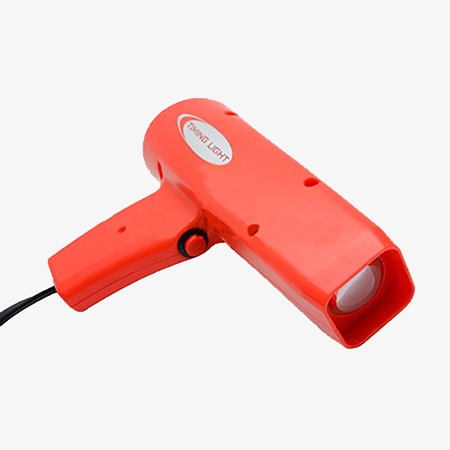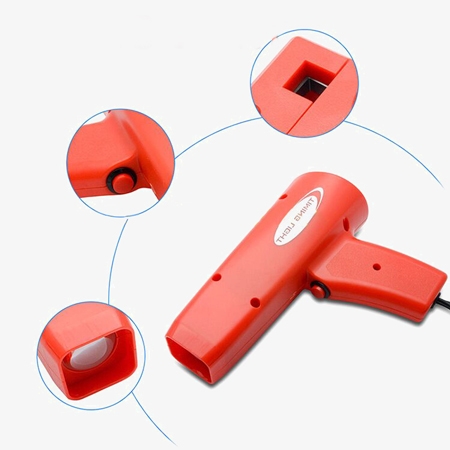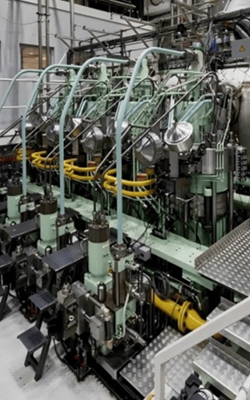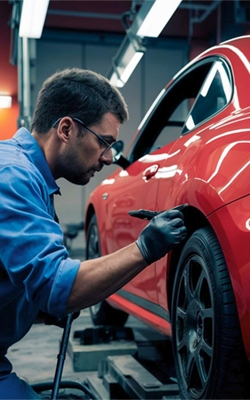The SISCO DC inductive timing light's heavy duty resin casing is strong, easy to clean and resistant to corrosives and most other chemicals that could get on it while you work. Handle pistol-type design conforms to the engineering design, the button is comfortable, feels good, facilitates the operation. The xenon timing light is suitable for car, motorcycle, all two-stroke and four-stroke gasoline engines, easily operate on 12V ignition systems.

Ergonomic Design for Comfortable Handling
- Ergonomic Design: Pistol-grip handle provides a comfortable hold, reducing fatigue during extended use.
- Focused Lamp Head: Square-shaped lamp housing delivers concentrated light with reduced scattering, ensuring timing marks are clearly visible.
- Vent and Mounting Holes: Built-in holes help with heat dissipation and also allow convenient hanging or storage.
- Durable Housing Material: Made from high-strength ABS plastic, lightweight yet impact-resistant, suitable for workshop and outdoor environments.
- Clear Identification: Marked with “TIMING LIGHT” on the body for easy recognition and to avoid confusion with other diagnostic tools.

The Inductive Timing Light Equipped with High-Intensity Lamp Head
- Inductive Pickup Clamp: The timing light detects high-voltage pulses from the spark plug wire through electromagnetic induction, with no need to cut or disconnect wires – safer and easier to use.
- High-Intensity Lamp Head: Equipped with a bright Xenon bulb, delivering strong strobe flashes that remain visible even under daylight conditions.
- Trigger Switch Control: Convenient trigger-style switch on the handle allows quick on/off operation, enabling simple one-handed use during engine testing.
- DC Power Supply: Powered directly from the vehicle’s 12V battery with alligator clips, ensuring stable performance.
Dimension

Application
SISCO timing lights are primarily used in the automotive and engine-related industries, including car repair and maintenance, motorcycle and small engine tuning, diesel and two-stroke engine testing, as well as performance tuning in racing and modification sectors. They help technicians and enthusiasts accurately set ignition timing to ensure efficient and stable engine operation.

Motorcycle

Small Engine Servicing

Two-stroke Engine Testing

Automotive Repair
| Model | SISCO-TL-CB |
| Power Supply Voltage | 12V |
| Material | ABS plastic |
| Size | 265*275*90 |
| Weight | 1kg |
Q1: What is a timing light?
A1: A timing light is a diagnostic tool used on internal combustion engines to check and adjust ignition timing. It produces a strobe light that flashes in sync with the spark plug firing, making timing marks on the engine’s crankshaft or pulley appear "frozen." This allows mechanics or enthusiasts to see if the spark is occurring at the correct point in the engine cycle and adjust it for better performance, efficiency, and smooth operation.
Q2: Why do I need a timing light?
A2: You need a timing light to make sure your engine's spark plug fires at the correct moment in the combustion cycle. Proper ignition timing improves fuel efficiency, engine power, and smooth operation, while preventing problems such as knocking, poor acceleration, overheating, or even long-term engine damage.
Q3: How does a timing light work?
A3: A timing light works by sensing the ignition pulse from a spark plug and flashing a strobe light in sync with it. When aimed at the timing marks on the crankshaft pulley or flywheel, the rotating marks appear “frozen,” allowing mechanics to check whether the spark occurs at the correct point in the engine cycle and adjust the ignition timing if needed.
Tips: Can I use a timing light on any engine?
A timing light cannot be universally applied to every engine, because it relies on detecting the electrical pulse that fires a spark plug. This makes it ideal for gasoline engines with spark-ignition systems, where the spark plug firing is a critical factor in combustion timing. For these engines, a timing light is the standard tool to verify and adjust ignition timing accurately. However, most diesel engines do not use spark plugs at all, relying instead on fuel injection and compression ignition, so a conventional timing light won’t work. Specialized diesel timing lights or other diagnostic tools are required in that case. Similarly, engines that use magneto ignition systems (often found in small engines, motorcycles, or older equipment) may require a magneto-specific timing light. In some two-stroke engines, depending on their ignition design, only certain types of timing lights are compatible. In summary, while a timing light is essential and highly effective for spark-ignition gasoline engines, different engine types may require specialized tools or methods.
Thank you for buying industrial test and measurement equipment on SISCO.com, all products sold by SISCO and the partner cover a 12 months warranty, effective from the date of receiving the products.
What is covered?
SISCO is responsible for providing free spare parts, and free technical support to assist the customer to repair the defective products until the problem is solved.
What is not covered?
- Product purchased from anyone other than a SISCO store or a SISCO authorized reseller.
- Expendable parts.
- Routine cleaning or normal cosmetic and mechanical wear.
- Damage from misuse, abuse or neglect.
- Damage from use of parts other than SISCO approved.
- Damage from use outside the product’s usage or storage parameters.
- Damage from use of parts not sold by SISCO.
- Damage from modification or incorporation into other products.
- Damage from repair or replacement of warranted parts by a service provider other than a SISCO authorized service provider.
- Damage caused by the application environment not meeting the product usage requirements and the failure to perform preventive maintenance.

